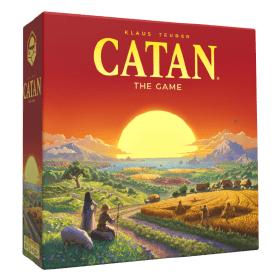CATAN The Settlers of Catan, Die Siedler von Catan, Les Colons de Catane
 Esmakordselt avaldatud 1995. aastal Saksamaal nimega „Die Siedler von CATAN“, seejärel inglise keeles 1996. aastal nime all „The Settlers of CATAN“ ilmunud CATAN tähistab 2020. aastal oma 25. aastapäeva.
Esmakordselt avaldatud 1995. aastal Saksamaal nimega „Die Siedler von CATAN“, seejärel inglise keeles 1996. aastal nime all „The Settlers of CATAN“ ilmunud CATAN tähistab 2020. aastal oma 25. aastapäeva.
Mängu alustamiseks ehita mängulaud kasutades kuusnurkseid maastikuruute. Sünnib Catan – kaunis saar mägede, karjamaade, küngaste, põldude ja metsadega, mida ümbritseb meri.
Igaüks teist asetab kaks väikest maja ruutudele, kus kohtuvad kolm maastikukuusnurka. Need on teie alustavad arveldused.
Ja nii see algab. Alustav mängija heidab kahte täringut. "11!" Iga maastikuruut on tähistatud numbriga. Iga mängija, kellel on veeretatud numbriga tähistatud maastikuruuduga külgnev asula, saab selle ruudu poolt toodetud ressursi. Mäed toodavad telliseid, metsad saematerjali, mäestikud toodavad maaki, põllud vilja ja karjamaad villa.
Sa kasutad neid ressurse, et laieneda Catanil, ehitades teid ja uusi asulaid või arendades enda olemasolevaid asulaid linnadeks. Näiteks tee ehitamiseks on vaja 1 savi ja 1 puud. Kui sul pole vajalike ressursse, saad neid endale läbi kauplemise teiste mängijatega.
Iga asula on väärt 1 võidupunkti ja iga linn on väärt 2 võidupunkti. Kui lainened nutikalt, võid olla esimene mängija, kes jõuab 10 võidupunktini ja seega võidab mängu!
Mängijate arv: 3 - 4
Mängu kestus: 38 mn
Keerukus: 2 / 5
Mängi CATAN ja 1021 other games veebis.
Allalaadimine ei ole vajalik - mängi otse oma veebibrauseris.
Oma sõprade ja tuhandete mängijatega kogu maailmast.
Vaba. Tasuta.

Mängi CATAN ja 1021 other games veebis.
Allalaadimine ei ole vajalik - mängi otse oma veebibrauseris.
Oma sõprade ja tuhandete mängijatega kogu maailmast.
Vaba. Tasuta.

Reeglite kokkuvõte
Objective
Get resources to buy various buildings and development cards, and try to be the first player to reach 10 points.
Setup
- The board consists of hills (brick), forest (lumber), mountains (ore), fields (grain), pasture (wool) and a desert (nothing) at random places.
- Each terrain except the desert has a number of 2-12 on it. The desert starts with the robber on it.
- Each player places 2 settlements and 1 road next to each settlement on the board, then they receive resources for each terrain around the second settlement.
Gameplay
Rolling for resource production (obligatory): On your turn, roll 2 dice and calculate the sum.
- The terrains with that number produce resources for all players who have settlements or cities next to them (if the robber isn't blocking them): 1 resource per settlement and 2 per city.
- If you roll a 7, no one gets any resources and players with 8 resources or more must discard half of them (rounded down). You must move the robber to a new terrain and steal 1 random resource from a player who has a settlement or city next to that terrain.
Trading (optional): during your turn you can trade resources
- • with all other players (domestic trade)
- • with the bank (maritime trade) at the standard rate of 4 identical resources for 1 or at a preferential rate of a harbour if you have a settlement next to it.
Building (optional): finally, you can build roads and settlements, upgrade settlements to cities or purchase a development card by paying the resources needed.
- • roads must connect to the initial settlements and cost 1 brick + 1 lumber (worth 0 points)
- • settlements must be connected by roads to existing settlements (except at start) and cost 1 brick + 1 lumber + 1 wool + 1 grain (worth 1 point)
- • cities replace an existing settlement and cost 3 ore + 2 grain (worth 2 points)
- • development cards cost 1 ore + 1 wool + 1 grain and include
- • 14 knight cards that allow to move the robber to another terrain and steal a resource
- • 2 road building cards allowing extra roads to be built
- • 2 year of plenty cards providing two free resources of choice
- • 2 monopoly cards giving all other players that help gathering resources or building road•s
- • 5 victory point cards
You can play a development card at any time during your turn, even before rolling the dice, as long as it was bought on a previous turn and is not a victory card.
Scoring
- • Settlements: each is worth 1 victory point.
- • Cities: each is worth 2 victory points (1 Point from the settlement + 1).
- • Victory point cards: some development cards are worth 1 victory point. They are kept hidden until you have sufficent points to win.
- • Largest army: the player who has played the most knight cards at any time (at least 3) gets the largest army card which is worth 2 points. No largest army in C&K.
- • Longest road: the player with the longest continuous road at any time (at least 5 segments) gets the longest road card which is worth 2 points.
If there is a tie, the original owner keeps the achievement cards.
End of game
If a player has 10 or more victory points during their turn (including victory points cards), they reveal them and the game ends with their victory. For Catan Cities & Knights, a player needs 13 or more victory points to win.
This is not Cities & Knights though.


